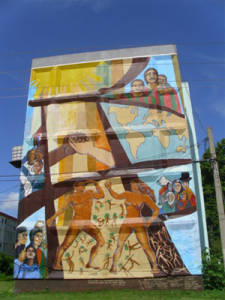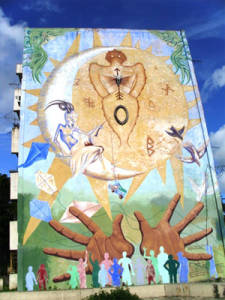A ‘Brown Agenda’ for Cuba
Haroldo Dilla Alfonso*

HAVANA TIMES, Dec 13 — Throughout my 11 long years as a member of the Cuban Communist Party, I would review — with complete seriousness — all of the documents prior to each party congress. I did this in relation to the 1990 Fourth Congress (my first), excited about its proposals for more internal debate and greater democratic spaces. I also reviewed the documents of the Fifth Congress, in 1997, but with absolute frustration, as that congress signaled retreat and my ultimate exasperation.
Now I’ve made a similar review of the document that is serving as the basis for the upcoming January Party Conference, which is supposed to deal with issues regarding the Party not dealt with at the Sixth Congress in April of this year.
The document is laconic, gray and contradictory. For example, it calls for creativity precisely in a country where creativity is severely punished when one transgresses the narrow norms of what is politically acceptable. Likewise, something nicer, it attacks dogmas while at the same time calling for the updating of the dogmatic rubbish that it calls “Marxism-Leninism.”
It gives the impression of being a schizophrenic document, distanced from the reality that it attempts to interpret. It is an overpowering demonstration of the political cretinism of a devalued organization.
Perhaps the greatest virtue of the document wasn’t intended: It informs us of the status of the intra-elite pact agreed to in 2009 to punish the bad boys that Fidel Castro had promoted in the 90’s as the finest interpreters of his thoughts, but who ended up being seduced “by the honey of power.”
It appears that a romance with no future has been struck between the party bureaucracy and military technocrats, who apparently started their maiden voyage with the most recent party congress (April 2011). It was then that the general/president gave his closing speech, lashing out at the party bureaucrats – despite having sworn that he wasn’t going to address issues of that nature.

In the same vein, the document reveals how Raul Castro is eliminating from the upper echelons the weight of this petty and parasitic bureaucracy, who are incapable of imagining a capitalist future, as does the military.
This isn’t because the members of the bureaucracy are socialists, but because they’re pre-capitalist and because they have thrived within the apparatus and lost the ability to imagine anything. This is why they have left this absurd but harmless exercise.
This is also because it was long ago that the party ceased being the driving force of the government and society, as stated in the constitution. Perhaps it acted close to this between 1975 and 1985, when Soviet subsidies imposed a certain order and institutionalism, but as an organization, it has gradually weakened since the beginning of the “rectification” period, as noted by Professor Eusebio Mujal.
Today this role is played by the Revolutionary Armed Forces, which has cornered the main governing bodies, particularly the Politburo. The fact that the Politburo is associated with the party is mere formalism; it actually belongs to the military and its technocrats.

This does not mean that the party is unimportant.
Within it are something like a million and half people, which include — along with opportunists of all stripes — honest people who believe in a better future different from that offered by capitalists.
Above all, however, it includes troops who are loyal — out of expedience or conviction — and are vital as supports of the system.
The party is, therefore, a structure of members who are more or less committed to the cause, willing to explain the government’s arguments, and who try to convince, but who ultimately suppress those who persist in thinking differently.
It is a formidable socio-political control apparatus; one that the Raulist updating — always concerned about un-programmed leaps — cannot do without.
Finally, it is a place for interaction between elite factions, it is a place where each band has something to contribute.
The reformists “updaters” provide the cadre for economic change, led by the ineffable Marino Murillo.

The conservative spectrum provides the managers who bring order to this feast of primitive accumulation – choosing who can participate, who can’t, and finally how one can participate without altering the rules.
Adding to all of this, as if pulled out of Raul’s sleeve, has appeared Gladys Bejerano, the comptroller in charge of prosecuting excessively outrageous corruption with a straight face and sharp language.
Whether this implies institutional heresy is a third level matter. Fidel Castro always ruled violating institutions, and even when he was sidelined he proceeded to assemble a structure parallel to everything that existed, forming it under the enigmatic banner of the “Battle of Ideas.”
Similarly, in faraway China, Deng Xiao Ping — the man who was only interested in cats hunting mice — had more power than an emperor, though under the discrete title of president of the military commission of the party.
In short, don’t expect anything dramatic from this party conference. It’s possible that the Machado Ventura faction will lose some positions, but what Raul Castro really needs in the party is a “gray man” [strict conservative] like Machado.
Machado is required to do the work of a dark band of officials who have forgotten the meaning of a smile, like the diabolical girl in the Adams family, but more predictable.
What we have then are gray men for a party that claims to be red but who will have to execute a “brown agenda” (as the environmentalists say), recycling the solid waste of the updating.
For all of that, and for the moment, Machado Ventura is ideal.
(*) Published originally in Spanish by Cubaencuentro.






It’s interesting, Haroldo, that you would make reference to Deng Xiao Ping as “the man who was only interested in cats hunting mice.” This apparently was a deprecatory reference. (I remember that Fidel once referred to him as “that little numbskull” for his experimental flexibility.)
What was Deng’s great sin? It was that he took an experimental approach to the problems of socialist construction. He said–famously, or infamously, depending on your point of view–that the color of a cat doesn’t matter, as compared to its ability to catch mice. All the Marxian sectarians, including Mao and Fidel, thought this was a negative, non-socialist way of thinking. But, was it really?
The same Marxists who bought into the notion that “real” socialism is following the full state monopoly recipe for socialist economy, have strutted around for over a century claiming that Marxism is based on science. But science is based on the Scientific Method, and this method is based on flexibility and experimentation.
What this means is that, if the mode of production the socialist state puts into place is not functioning well, then the experiment should be altered and refined until the results prove satisfactory. Marxists however are unable to take such an experimental approach, unable to have an experimental frame of mind, unable to judge the value of a cat by its ability to catch mice, rather than by its rhetorical color.
It’s true that Deng’s experimentation has led the Chinese revolution astray in many ways. But would it have been better if it had followed the Marxian formula to the bitter end? What socialist construction needs is an experimental frame of mind. One part of achieving this is looking deeply at the “cat” analogy made famous–or infamous–by Deng Xiao Ping.
There is a third way between monopoly capitalism and Marxian state monopoly socialism. It is modern cooperative socialism, the economic foundation of which has been proved experimentally by the Basque/Mondragon Spanish workers and their professional leaders. All that is needed for “real” socialism is to add a sincere, flexible, transformationary state power and a National Plan.